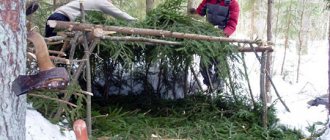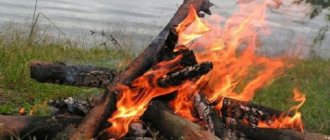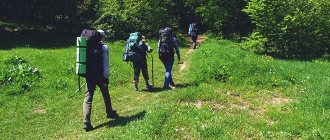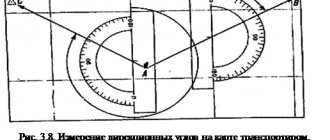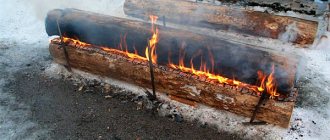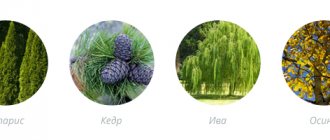Rules for making a fire in the forest
Almost every person has had the opportunity to go hunting, fishing or hiking, and also had to deal with making fires. In this case, it is better to know the basic rules of breeding, since there are many different species that require an individual approach.
Here are a few types.
- Hut. A popular type of fire that tourists use on their travels. In this version, the logs need to be folded at an angle towards the center. This fire is perfect for cooking.
- Well. This type differs from the previous one in the following way: you can cook several dishes on it at once. This design consists of logs stacked parallel to each other, with two more logs placed across them. You choose the height of such a structure yourself.
- Taiga. Such a fire burns all night, and gives off more heat so that you can warm up on cold nights. To create such a fire, you will need two rows of large logs or logs, the rows must intersect at an angle above the coals. The first row is laid tightly.
- Fireplace. This type of fire is ideal for heating at night. It burns long enough. This design is made from several logs; it needs to be laid in the form of a well, and a wall should be laid out on one side.
- Star. When you have very few logs on hand, you can make such a fire. It is economical as a fuel, but under no circumstances should you ignore it. The star is laid out lengthwise along the radius of the fire.
You can read more about the types of fires on our website.
Fire safety when making fires
There are several specific rules for making fires in the forest, as well as monitoring the fire. Such a simple safety technique that tries to protect not only people, but also animals and plants. A burning fire should not be left unattended. Since the flame can rise and spread to something due to strong wind. Putting out the fire is a must if you are about to go to bed. Otherwise, you may simply get caught in the fire and get injured. And sparks can set fire to your clothes or the tent you're in. Fires must be lit at a distance of more than 10 meters from the shelter. The tent is set up from the back. In the mountains the wind blows differently, usually from the valley. Therefore, place it as close to the river as possible.
We recommend reading:
Sights of Venice
The rules do not recommend using fir branches for fires. Most often it is necessary to use birch bark. Pines and cedars create combustion well. Birch logs create a lot of sparks, but provide more heat. You must make a fire in coniferous areas no less than 15 meters from the trees.
Choosing wood for firewood
When choosing the type of wood for firewood, you need to understand that not every wood is equally good. For example, firewood from one type of tree will produce more heat than firewood from another, some will be lighter and others will be heavier, some will take up more space, others less, some will burn with an even quiet flame, while others will shoot sparks, and so on. etc.
Speaking about the temperature and heat that firewood can produce during combustion, it should be noted that usually the mass calorific value of coniferous trees exceeds that of deciduous trees. This means that for the same mass, coniferous trees will produce more heat. However, due to the low density of needles, it loses to deciduous species in volume. In other words, for the same amount of heat generated, the volume of coniferous wood will take up more space than the firewood of deciduous trees.
Wood that sparks and shoots sparks can cause a fire or turn your tent into a colander. In general, firewood crackles and shoots in a fire for several reasons:
- The boiling of water and resin in the wood leads to excess pressure, which pulls out the burning chips and can throw them some distance from the fire.
- Pyrolysis gases, which are released from wood when heated, can also cause uneasy combustion of wood.
- Thermal deformation of wood during combustion also creates wood crackling in the fire.
Now let’s briefly look at the characteristics of some types of wood:
- Birch. It burns well and for a long time, hardly shoots, and its bark, called birch bark, can be used as good kindling, capable of burning even after rain. In my opinion, birch makes the best firewood;
- Oak. It burns long and hot, but it is one of the hardest rocks, which affects its processing (felling and cutting into firewood). Among other things, oak wood does not light very easily, so it is better to place it on already burning brushwood from other types of trees.
- Larch. Firewood from it burns for a long time, but sparks quite strongly. The coals from such firewood smolder for a long time.
- Willow. It burns brightly, but burns out quickly, leaving almost no coals. The willow fire sparkles and sometimes crackles.
- Alder. Burns long and evenly. It produces a lot of heat, smokes little and hardly sparks, which makes it a good fuel for a fire.
- Pine. Lights up easily, but burns out quickly. A fire made from pine wood can sometimes spark. Additionally, pine resin can be used to start a fire in wet weather.
- Poplar. Firewood from this tree burns poorly and produces acrid smoke.
- Spruce and fir. These two types of trees are not recommended for fires because they smoke a lot, constantly shoot coals and burn out quickly.
As a last resort, you can burn any wood, because, as you know, without fish there’s fish. There is practically no firewood that is completely unsuitable for a fire : even a rotten log that is completely wet can be dried near a flame that has already flared up and then put on the fire - it will fulfill its purpose. The only question is to use the most suitable fuel in it at different stages of building a fireplace.
Video: Harvesting firewood without an ax and saw
What you should not do when making a fire
- Light a fire in the forest only when absolutely necessary and in special places.
- If there is no such place in this area, then prepare a special area for making a fire, clear it of grass right down to the ground.
- Before leaving the camp, the fire must be well extinguished. Leave the resting place only after making sure that the logs are no longer burning or smoldering.
- Try to avoid thoughtlessly throwing out unextinguished cigarette butts and matches.
- If you find the slightest signs of fire, immediately apply extinguishing measures; extinguish the fire using water. Throw earth at the fire; you can also use branches to fight the fire.
- It is urgent to notify forest workers.
- If you cannot cope with the fire yourself, then report it by calling the rescue line.
Safety rules for forest fires
The forest and its wild inhabitants should not suffer from our rest.
To avoid the tragedy of forest fires, it is necessary to consider safety when lighting an open fire.
It is doubly offensive to suffer yourself - sparks from burning some trees shoot far, igniting tents, sleeping bags, equipment, and clothes.
- Find a place for the fire, taking into account the distance from trees, bushes, overhanging crowns, and places where you will spend the night.
- On the leeward side, the distance from the fireplace should be at least 10 meters, on the windward side - 5 meters.
- Clear a surface with a diameter of about 2 - 3 meters from dry grass and leaves.
- If you have a shovel, dig a shallow hole for the fire pit; if you don’t have a shovel, cover its edges with stones or a mound of soil and sand.
- If there is grass growing, or the soil is damp, carefully remove the top layer of turf, placing it outside the fire pit.
- Extinguish the fire carefully - it is not enough to simply extinguish the flame, you also need to cool the coals.
- Water the fire with water, then cover it with soil.
We suggest you read: How to transplant a chestnut tree to a new place in the fall
Important! Avoid peat bogs under fires - after extinguishing the fire, the peat will continue to smolder, causing a fire over time, and nature will suffer enormous damage!
What to do if a fire starts
If you make a mistake and a fire still occurs, don't waste a second. Immediately call the rescue number and report the location of the fire and begin extinguishing the fire:
- if there is a source of water near you, then immediately try to pour it on the fire;
- it is necessary to water all nearby plants, as this will help prevent the fire from spreading;
- you can make a broom from twigs and try to use it to sweep the edge of the fire on the sides, this is done by bending towards the flame, in this case the broom needs to be turned all the time;
- Next, you need to throw a damp and loose piece of earth on the fire, you can also try to fence off the fire site;
- if you manage to extinguish the fire, do not be lazy and report it to the forestry department;
- If you are unable to cope on your own, do not stop trying and wait for the rescue service.
We recommend reading:
Teriberka - a trip to the ends of the earth! - unusual excursions in Murmansk
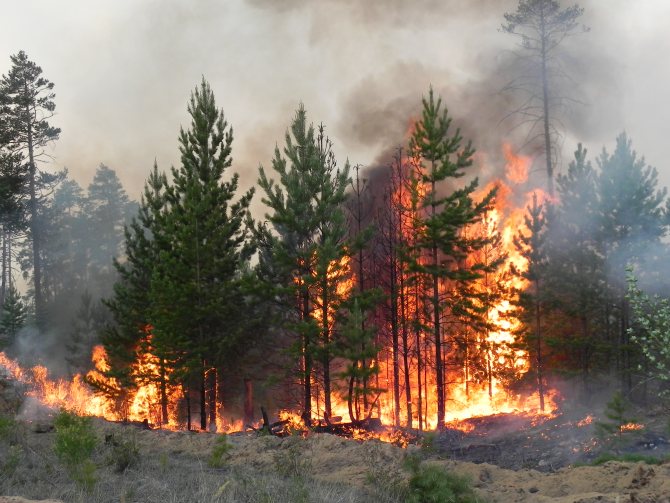
Follow all safety precautions when handling an open fire in a forest area. You can ideally and well relax in nature, do not harm it.
Rules for extinguishing a fire
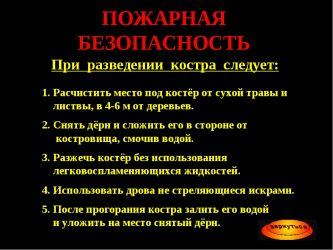
The forest is the green clothing of the earth and our greatest wealth. The most formidable enemy of the forest has always been fire. Currently, in most cases of fire, the person himself is to blame. But by following simple fire safety rules in forests, you can preserve nature and prevent a large-scale disaster.
Forest fires leave behind areas devastated for a long time. And they sometimes begin due to underestimation of the danger of fire and violation of rules of behavior in the forest. A dropped cigarette butt, discarded glassware after a picnic, and an unextinguished fire are all potential fire hazards.
Green tourism has become very fashionable in modern society. But not all new tourists even know the basics of fire safety in nature. Without thinking about the consequences, they build a fire for cooking under trees, near bushes, and do not monitor it.
What you should not do when making a fire
Choosing a place for a fire is a simple task, but always necessary. If the place is chosen incorrectly for the fire, then inconvenience may occur, for example, smoke that flies towards the shelter. In others, this threatens the traveler with big problems, for example, a fire. If you follow a few rules, this will allow you to avoid many of the troubles that are associated with creating a fire outdoors.
Here are some simple rules.
- It is prohibited to make fires close to thickets of dry grass and bushes. Even a small spark that flies out of the fire is enough to start a fire.
- It is not recommended to make fires in thickets of young pine. This rule is stated in the law.
- You cannot make a fire at the forest preparation site, provided that wood debris is present. It can easily ignite, causing a large fire.
Author of the publication
offline 2 years
Nika
7
I am interested in hiking and traveling, photography and videography. I have been going hiking since childhood. The whole family went and went - sometimes to the sea, then to the river, to the lake, to the forest. There was a time when we spent a whole month in the forest. We lived in tents and cooked over fires. This is probably why I am still drawn to the forest and, in general, to nature. I travel regularly. About three trips a year for 10-15 days and many 2 and 3 day hikes.
Comments: 0Publications: 668Registration: 10/23/2018
Nika Survival in the wild, Fire, heat, Articles
What is prohibited during fire danger?
The rules for making a fire during a fire danger period have many prohibitions. It is forbidden (even if absolutely necessary) to light a fire in forest areas during periods of increased fire danger. This situation can occur from May to September. The rules strictly prohibit making fires:
- in coniferous and pine young growth;
- on windfalls;
- in windbreaks;
- at cutting sites where wood is harvested or there are logging residues;
- in fields with ears of crops;
- in the steppes with dried grass;
- in clearings with dry grass;
- next to reeds, moss and reeds;
- on or near peat bogs;
- under the canopy of trees;
- on old fire pits.
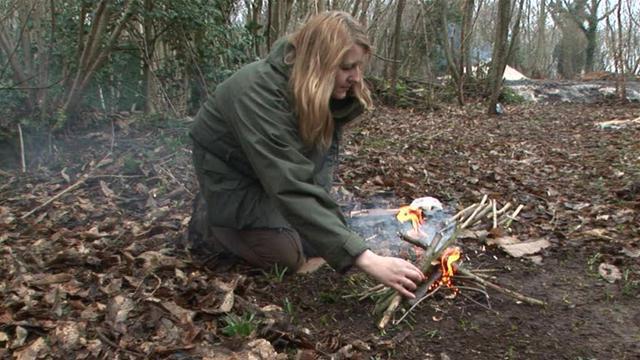
Fires should be located only in open areas, at a reasonable distance from thickets of vegetation and bushes. And first of all, keep away from dry grass. During the fire danger period, it is prohibited to use barbecues or any devices for cooking food in the forest.
You cannot smoke, throw away cigarette butts and burning matches, or shake out ash from pipes. It is prohibited to use pyrotechnics or shoot firearms. Material soaked or oiled with flammable substances should not be left in forests. It is prohibited to fill tanks with fuel and leave glass bottles, their fragments and other debris in the open space.

